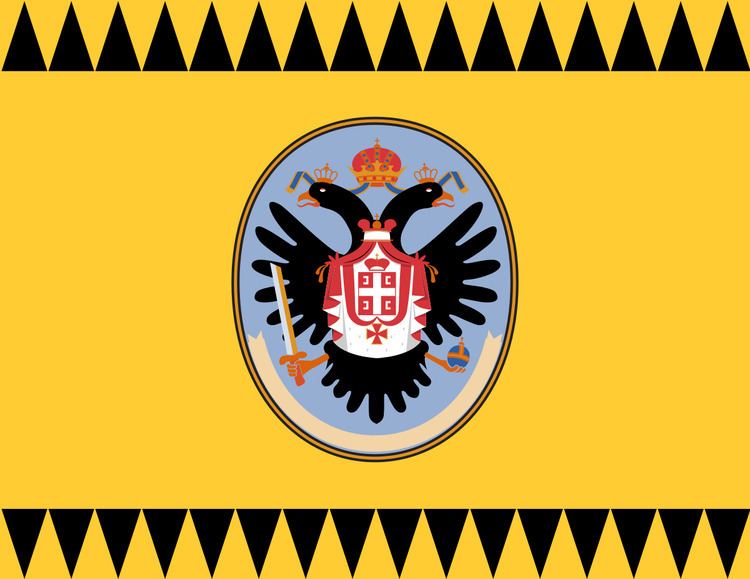1849–1860 → Government Voivodeship Disestablished 27 December 1860 | Capital Temeschwar Established 18 November 1849 | |
 | ||
Today part of Serbia
Romania
Hungary | ||
Voivodeship of serbia and banat of temeschwar
The Voivodeship of Serbia and Banat of Temeschwar or Serbian Voivodeship and the Banate of Temes (Woiwodschaft Serbien und des Temescher Banates), known simply as the Serbian Voivodeship, was a province (duchy) of the Austrian Empire that existed between 1849 and 1860.
Contents
- Voivodeship of serbia and banat of temeschwar
- Names
- History
- Languages
- Demographics
- 1846
- 1857
- 185051
- 1860
- Administrative divisions
- Great Voivodes
- Governors
- References
It was a separate crown land named after two former provinces: Serbian Vojvodina and Banat of Temes. Its former area is now divided between Serbia, Romania and Hungary. The Voivodeship gave its name to the present Serbian Autonomous Province of Vojvodina.
Names
In contemporary German, the duchy was officially known as Woiwodschaft Serbien und das Temescher Banates or Woiwodschaft Serbien und das Temeser Banat(e). In contemporary Serbian it was known as Vojvodina Srbska i Tamiški Banat (Войводина Србска и Тамишки Банат) and Vojvodstvo Srbija i Tamiški Banat (Војводство Србија и Тамишки Банат). In Hungarian it was known as Szerb Vajdaság és Temesi Bánság, and in Romanian as Voivodina Sârbească și Banatul Timișan.
In various sources (both, Serbian and German) there are two somewhat different variants of the name of the voivodeship, one could be translated into English as Voivodeship of Serbia and Temes Banat and another as Serbian Voivodeship and Temes Banat.
Also in modern English use, the term Temes Banat or Banat of Temes is sometimes incorrectly replaced with term Banat of Temeschwar or Temeschwar Banat. In the original name in all native languages, there is no mention of the city of Temeschwar (Timișoara) in the title of Voivodeship. As shown above, the reference to the Temes region is always used, and should be translated into English as Temes Banat or Banat of Temes.
History
The Voivodeship was formed by a decision of the Austrian emperor in November 1849, after the Revolutions of 1848/1849. It was formed in accordance with privilege given to Serbs by the Habsburg emperor in 1691, recognizing the right of Serbs to territorial autonomy within the Habsburg Monarchy.
It consisted of the regions of Banat, Bačka and northern Syrmian municipalities of Ilok and Ruma. An Austrian governor seated in Temeschwar ruled the area, and the title of Voivode belonged to the emperor himself. The full title of the emperor was "Grand Voivod of the Voivodeship of Serbia" (German: Großwoiwode der Woiwodschaft Serbien). Even after the Voivodeship was abolished, the emperor kept this title until the end of Austro-Hungarian Monarchy in 1918.
In 1860, the Voivodeship of Serbia and Temes Banat was abolished and most of its territory (Banat and Bačka) was incorporated into the Habsburg Kingdom of Hungary, although direct Hungarian rule began only in 1867, after the Austro-Hungarian Compromise, when Kingdom of Hungary gained autonomy within newly formed Austria-Hungary. Unlike Banat and Bačka, in 1860 Syrmia was incorporated into the Kingdom of Slavonia, another separate Habsburg crown land. Kingdom of Slavonia subsequently joined with the Kingdom of Croatia forming new kingdom named Croatia-Slavonia, which made a pact with the Kingdom of Hungary in 1868, hence becoming self-governed part of the Kingdom of Hungary within Austria-Hungary.
Languages
The two official languages of the Voivodeship were German and "Illyrian" (what would come to be known as Serbo-Croatian).
Demographics
The Voivodeship was ethnically very mixed, since the southern parts of Syrmia, Banat and Bačka with compact Serbian settlements were not included in it, while eastern Banat, with a Romanian majority was added to it.
1846
According to the 1846 census, the territory that in 1849 formed the voivodeship included:
1857
In 1857, population of the voivodeship numbered 1,526,105 inhabitants, including:
1850/51
According to the 1850/51 census, ethnic composition of the voivodeship was as follows:
(*) Total number of "Illyrian Slavs" (Serbs, Bunjevci, Šokci, and Croats) was 386,906.
According to another source, in 1850/1851, the population of the voivodeship numbered 1,426,221 inhabitants, including:
By religious makeup:
In 1851, population of the voivodeship numbered 1,426,221 inhabitants, including:
1860
In 1860, population of the voivodeship numbered 1,525,523 inhabitants, including:
Administrative divisions
At first, Voivodeship was divided into two districts:
- Batschka-Torontal (Bačka-Torontal)
- Temeschwar-Karasch (Timișoara-Caraș)
Later, it was divided into five districts:
- Großbetschkerek / Veliki Bečkerek (In 1850, population of the district numbered 388,704 inhabitants, including: 126,730 Germans, 124,111 Serbs, 60,781 Hungarians, 58,292 Romanians, 11,045 Bulgarians, 3,752 Croats, 2,562 Slovaks, 1,421 Jews, etc.)
- Lugosch / Lugoj (In 1850, population of the district numbered 229,363 inhabitants, including: 197,363 Romanians, 21,179 Germans, 8,305 Bulgarians, 1,505 Hungarians, 612 Serbs, etc.)
- Neusatz / Novi Sad (In 1850, population of the district numbered 236,943 inhabitants, including: 100,382 Serbs, 45,936 Germans, 30,450 Hungarians, 20,683 Slovaks, 13,665 Šokci, 2,098 Jews, etc.)
- Temeschwar / Timişoara (In 1850, population of the district numbered 316,565 inhabitants, including: 159,292 Romanians, 101,339 Germans, 34,263 Serbs, 12,412 Hungarians, 3,664 Bulgarians, 2,307 Šokci, 1,650 Slovaks, etc.)
- Zombor / Sombor (In 1850, population of the district numbered 376,366 inhabitants, including: 160,016 Hungarians, 103,886 Germans, 53,908 Bunjevci, 40,054 Serbs, 7,830 Jews, etc.)
